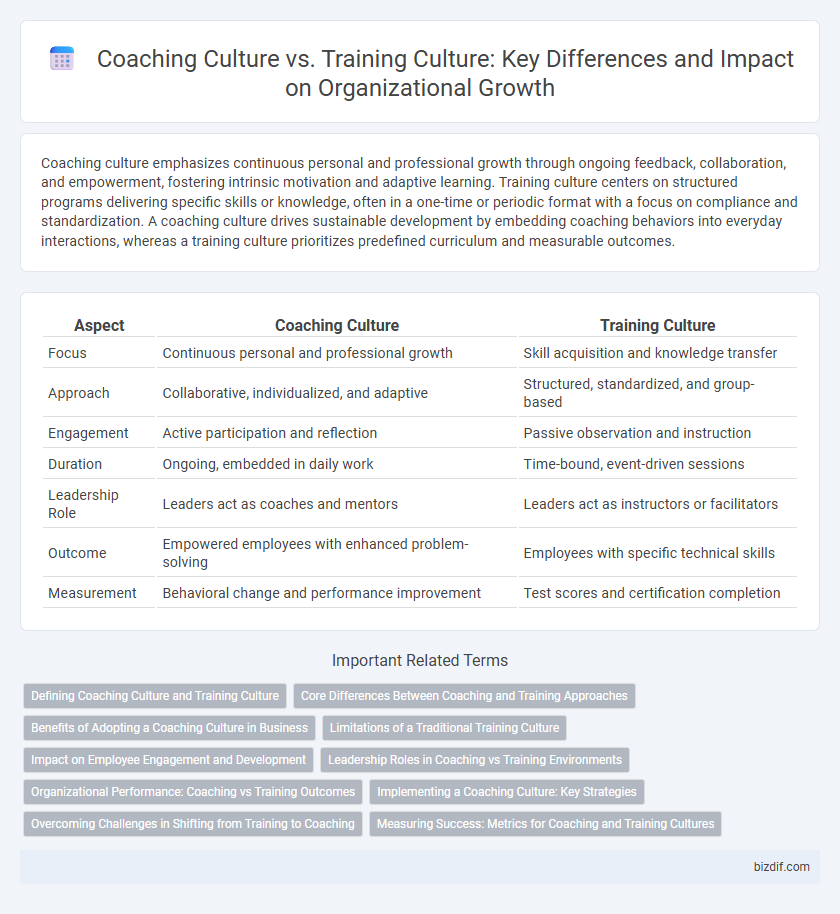Coaching culture emphasizes continuous personal and professional growth through ongoing feedback, collaboration, and empowerment, fostering intrinsic motivation and adaptive learning. Training culture centers on structured programs delivering specific skills or knowledge, often in a one-time or periodic format with a focus on compliance and standardization. A coaching culture drives sustainable development by embedding coaching behaviors into everyday interactions, whereas a training culture prioritizes predefined curriculum and measurable outcomes.
Table of Comparison
| Aspect | Coaching Culture | Training Culture |
|---|---|---|
| Focus | Continuous personal and professional growth | Skill acquisition and knowledge transfer |
| Approach | Collaborative, individualized, and adaptive | Structured, standardized, and group-based |
| Engagement | Active participation and reflection | Passive observation and instruction |
| Duration | Ongoing, embedded in daily work | Time-bound, event-driven sessions |
| Leadership Role | Leaders act as coaches and mentors | Leaders act as instructors or facilitators |
| Outcome | Empowered employees with enhanced problem-solving | Employees with specific technical skills |
| Measurement | Behavioral change and performance improvement | Test scores and certification completion |
Defining Coaching Culture and Training Culture
Coaching culture emphasizes continuous personal and professional growth through one-on-one dialogue, feedback, and empowerment, fostering a collaborative environment where employees take ownership of their development. Training culture centers on structured learning programs with clearly defined curricula designed to deliver specific skills and knowledge in a more formal, instructor-led setting. Organizations with a coaching culture prioritize adaptability and employee engagement, while those with a training culture focus on standardized competency acquisition and performance metrics.
Core Differences Between Coaching and Training Approaches
Coaching culture emphasizes personalized development, fostering self-awareness, critical thinking, and long-term behavioral change through continuous feedback and reflective dialogue. Training culture focuses on structured learning, delivering predefined knowledge and skills in a more rigid, instructor-led environment aimed at immediate competency acquisition. Core differences include coaching's adaptability to individual needs versus training's standardization, and coaching's goal of empowering autonomy compared to training's emphasis on content mastery.
Benefits of Adopting a Coaching Culture in Business
Adopting a coaching culture in business fosters continuous personal and professional development, leading to enhanced employee engagement and improved performance. This culture encourages open communication and accountability, which drives innovation and agile problem-solving across teams. Companies with a coaching culture experience higher retention rates and stronger leadership pipelines, positioning them for sustained competitive advantage.
Limitations of a Traditional Training Culture
Traditional training culture often relies on one-time, instructor-led sessions that limit ongoing skill development and fail to address individual learner needs. This approach restricts employee engagement and adaptability by emphasizing information delivery over continuous feedback and personalized growth. Consequently, organizations with a strong training culture may struggle to foster the collaborative, reflective mindset essential for sustainable performance improvement in dynamic work environments.
Impact on Employee Engagement and Development
A coaching culture fosters continuous feedback, personalized growth, and empowerment, significantly enhancing employee engagement and long-term development. In contrast, a training culture often emphasizes standardized skill acquisition with limited follow-up, leading to lower retention and less sustained motivation. Organizations adopting a coaching culture report higher productivity, improved job satisfaction, and stronger leadership pipelines compared to traditional training environments.
Leadership Roles in Coaching vs Training Environments
Leadership roles in coaching culture emphasize personalized development, fostering trust, active listening, and facilitating self-discovery to enhance employee performance and engagement. In training culture, leaders primarily focus on delivering structured content, ensuring compliance, and measuring skill acquisition through standardized assessments. Coaching leaders build adaptive skills and emotional intelligence, while training leaders prioritize knowledge transfer and procedural adherence.
Organizational Performance: Coaching vs Training Outcomes
A coaching culture fosters continuous development by emphasizing personalized feedback and long-term growth, leading to sustained improvements in organizational performance. Training culture often focuses on short-term skill acquisition with standardized programs that may not address individual employee needs or adaptability. Organizations embracing coaching see higher employee engagement, innovation, and resilience, directly enhancing overall business outcomes compared to those relying primarily on traditional training methods.
Implementing a Coaching Culture: Key Strategies
Implementing a coaching culture requires prioritizing continuous feedback, fostering trust, and embedding coaching behaviors at all organizational levels. Key strategies include equipping leaders with coaching skills, aligning coaching practices with business objectives, and creating safe environments for open dialogue. Measuring coaching effectiveness through employee engagement and performance metrics ensures sustainable cultural transformation.
Overcoming Challenges in Shifting from Training to Coaching
Transitioning from a training culture to a coaching culture requires overcoming resistance to change and redefining leadership roles to prioritize continuous development over one-time skill acquisition. Organizations must address ingrained habits by fostering psychological safety and encouraging open dialogue, enabling employees to embrace vulnerability and growth mindsets. Leveraging data-driven feedback mechanisms helps measure coaching effectiveness and sustain momentum throughout the cultural shift.
Measuring Success: Metrics for Coaching and Training Cultures
Measuring success in a coaching culture relies heavily on qualitative metrics such as employee engagement scores, feedback frequency, and improvements in individual performance reviews, highlighting ongoing development and behavioral change. In contrast, a training culture often emphasizes quantitative metrics like course completion rates, test scores, and time-to-competency benchmarks to evaluate program effectiveness. Organizations integrating both cultures benefit from tracking blended metrics including retention rates, productivity increases, and learner satisfaction to gain a comprehensive view of developmental impact.
Coaching Culture vs Training Culture Infographic

 bizdif.com
bizdif.com